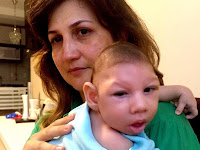Music therapy effect on
premature and
newborn infants
Music
Therapy is the clinical and evidence-based use of music to accomplish
individualized goals within a therapeutic relationship with a board certified
music therapist. Music Therapy is an established health profession in which
music is used to address physical, emotional, cognitive, communication and
social needs of individuals.
Live
music, played or sung, helped to slow infants’ heartbeats, calm their
breathing, improve sucking behaviors important for feeding, aid sleep and
promote states of quiet alertness. Specific
elements of music have therapeutic qualities that may be beneficial to a
growing premature infant. Premature and low birth weight infants respond to
their new surroundings with increased levels of agitation, which can cause
fluctuations in both the heart rate and blood pressure. Hearing is possible as
early as 24 weeks of gestation.
Loud noises and abrupt peaks in sound levels
from sources such as ventilators, monitor alarms, and even cabinet doors can
affect an infant’s blood oxygen levels, impair cerebral blood flow, and alter
the sleep-wake cycles which are necessary for development, maturation and
weight gain. Exposure to music therapy has been proven to calm the infant and
helps reverse the stress response. A number of studies reveal that babies who
experience music therapy are more content, feed better, and experience shorter
length of stay in the hospital. The vibrations and soothing rhythms of music,
especially performed live in the hospital, might benefit preemies and other
sick babies.
The music works best at relieving babies' stress and helping
parents bond with infants too sick to go home. Some families request rock music
or other high-tempo songs, but doctors say always slows the beat to make it
easier on tender ears. Music therapists say live performances in hospitals are
better than recorded music because patients can feel the music vibrations and
also benefit from seeing the musicians.
Music is such a huge part of our lives
and to do something like this, make it a sort of healing process, is a cool
thing. The music appeared to slow the infants' heartbeats, calm their
breathing, and improve sucking and sleeping. Playing womb-like music helps
soothe pre-term babies and their parents, improving the infants' sleeping and
eating patterns and increasing opportunities for parent-child bonding. Overall,
music helped improve the infants' vital signs, sleep patterns and feeding.
Music
Therapists are specially trained to teach pregnant women how to use music for
relaxation and as a reminder of visual imagery. Music can be a means of
changing a woman’s perception of pain during labor and delivery, thus
eliminating or reducing the amount of anesthesia that is used during the birth
process. The music therapist can often accompany the pregnant woman through
labor and delivery.
During
pregnancy, music can also be used for the baby. Prior to birth, babies may
respond to music while in the womb. From personal experience, my son always
kicked the exact spot on my abdomen that my guitar was touching. He would kick
to each strum that I played on the guitar. It seemed that he became more active
when he heard and felt the music. My daughter had a different response. She
became quieter, less active when she heard and felt the music. They both
continued their same womb responses after birth. Thus my son needed quiet to go
to sleep and my daughter needed quiet music.
Lullabies from around the world
all have a similar tempo. The tempo of a lullaby matches the tempo of the human
heartbeat. Lullabies can be used to comfort crying babies and help them feel
secure when going to sleep. When we sing lullabies to our children, we are
nurturing them and communicating our love. Incorporating lullabies into a
bedtime ritual can help children make the difficult transition into sleep.
Lullabies can also be used if a child wakes up at night, has a nightmare or is
sleeping away from home. With a lullaby in the background, babies and children
can feel even more emotionally secure and safe when being held close to your
body while you gently dance around a room or rock slowly in a rocking chair.
Children
love to move to the beat of a drum. You can use different rhythms to indicate
how to move. Play fast and children can run. Play very slow steady beats for
big steps, softly for tiptoeing, silence for stopping, or make up your own.
Doing this type of activity with children helps to develop listening skills,
sound discrimination, awareness of starting and stopping (this could become
part of safety awareness), as well as develop gross motor skills. Music can be
used to teach and improve speech and language.
Music incorporates rhythm, pitch
and words, which are all part of speech and language. Both sides of the brain
are used with music, so information can be learned through music and eventually
transferred into speech and language. Popular songs can be used to teach
children different skills. You can do the motions hand over hand with your
child. They love the physical touch, the play, the eye contact and most of all
the love that comes from being with their parents. Music therapy uses music as
a vehicle to achieve nonmusical goals. When a child has special needs, music
may be one of the most powerful ways to reach her and to help her to function
at her maximum potential.






















